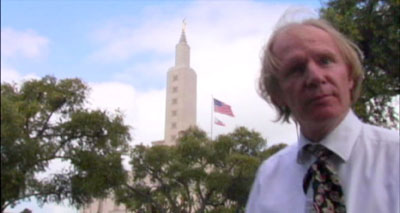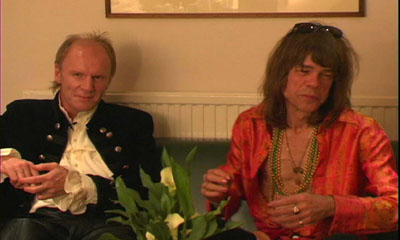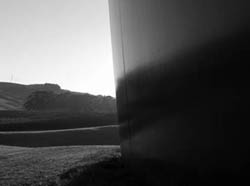Jia Zhangke’s Unknown Pleasures was eye-opening, the tale of two disaffected slackers told in a Chinese-inflected, naturalist style.
Now Jia has turned his eye on a symbol-soaked Chinese theme park full of miniature world landmarks, which provides the impossibly contrived backdrop for an unassuming, bleak narrative. Roger Ebert loves it.
The World, dir. by Jia Zhangke [ebert via archinect]
Category: movies
Star Wars: Full Of Cremaster-y Goodness
When watched together, in sequence, Film professor Aidan Wasley says, the Star Wars 6-ilogy is actually revealed to be the world’s greatest art film, ever:
Star Wars, at its secret, spiky intellectual heart, has more in common with films like Peter Greenaway’s Prospero’s Books or even Matthew Barney’s The Cremaster Cycle than with the countless cartoon blockbusters it spawned. Greenaway and Barney take the construction of their own work as a principal artistic subject, and Lucas does, too.
Wasley goes on to talk about Lucas’s interest in both the “never in a bajillion years long, long time” narrative coincidences which make up the films; and the deterministic, aesthetic order that is required for the thousands of CGI scenes.
So you mean the stilted storytelling and embarassing acting is good because Lucas intended it that way? I think that by defining “art films” as the uncompromised vision of a single individual–who we’ll call an artist–then yes, Cremaster and Star Wars are both art films. But don’t expect critical or audience opinion to be swayed by someone re-ascribing a whole host of a film’s shortcomings as the artist’s intention.
There’s as much risk of turning out a dud from this kind of mythic, singular, lone artist process as there is from the much more maligned studio-meddling/compromising hack process. Think Gangs of New York, Baseketball and Team America World Police.
Star Wars: Episodes I-VI, The greatest postmodern art film ever. [slate via kottke]
Previously: On watching Cremaster 1-5 in order
NY Doll: A Documentary By The Book (Of Mormon)

There was a Church film in the 70’s that showed what happens when you don’t do your home teaching. Mike Farrell (the BJ-Hunniccutt-on-M*A*S*H guy) played an auto mechanic/Mormon bishop, who asks a young, career-focused lawyer in his congregation to be a home teacher to a troubled family where the father was becoming less active in the Church. Time goes by, the lawyer’s busy and can’t ever find the time to visit the family each month and check in on their spiritual well-being. One evening, he gets a distraught phone call from Sister Brown: her husband’s gone, fed up, the last straw, and now they’re getting a divorce. “Is there anything I can do to help?” the lawyer asks, which sets the wife up to drive the film’s message home: “There was probably a time when you could have done something, but now it’s too late.”
Greg Whiteley’s first film, N.Y. Doll, on the other hand, is a testament to the blessings that can come from doing your home teaching. Not only does your home teachee get his band back together after 30 years, your first film gets a raucous reception at Sundance.
When Whiteley was assigned to be fellow Los Angeles ward member Arthur Kane’s home teacher, all he really knew was that the middle-aged Kane was a quiet, seemingly rootless reformed alcoholic who’d been in a band as a kid, long before he joined the Church.
Typically, home teaching takes the form of short, friendly, monthly visits, where you read a verse or two, share a prepared inspirational message from church leaders, and ask, slightly awkwardly, “Is there anything we can do for you?” And every once in a while, you help someone move.
Arthur Kane’s home teachers, including Whiteley and the guy before him, who’s interviewed in the movie, clearly magnified their callings. They gave Arthur money to get his prized bass guitar out of hock. Whiteley started videotaping Kane, making him the star of a film which, at the time, had no story and no prospects; all the big, archetypal plotpoints that occur in NY Doll–the Dolls reunion, the intervention of Morrissey, Kane’s illness–only happened after filming had begun.
[At least that’s how it appears. Most of the footage in the film appears to have been shot in small, intense bursts, even single sittings: Kane on the bus, at the Family History Center, the NYC reunion/rehearsal, picking up all the rock legend interviews backstage at the Meltdown 2004 performance in London. It’s entirely possible that N.Y. Doll started out as a favor from a filmmaker, to help a friend tape his conversion story and his colorful personal history.]
In any case, NY Doll deftly and sensitively navigates two, even three paths as it tells Kane’s tale: there’s the VH1-style “where are they now?”/reunion rockumentary; the tearjerking, feel-good “grant a wish” by-the-book PBS special; and–and I don’t imagine many people, Mormon or not, will spot this–a matter-of-fact lesson in the exercise of religious faith.
While the NY preview audience [heathen journalists all] I saw the film with tittered at the mention of answered prayers, miracles, and Kane’s explanation of how the Holy Spirit revealed The Book of Mormon’s truthfulness to him [“it’s like an acid trip from the Lord”], that kind of experience and language will seem utterly commonplace to LDS audiences. So much so, that it may go unnoticed; but Whiteley’s ability to document LDS religious doctrine and sentiment without resorting to either media-outsidery cynicism or church-insidery didacticism is such a rare achievement, I’m tempted to call it a miracle. He that hath ears, let him hear, I guess.

The film’s arcs aren’t perfect, however, just the best they got on tape; I would have liked some more from Kane on the breakup and supposed bad blood that kept him and Doll lead singer David Johansen apart for 30 years. This reconciliation/making amends thread is pegged by his bishop–and by Kane himself–as the real dream-come-true; it’s the “right” answer, Jesus-wise, but in retrospect, it didn’t feel supported by the reunion buildup. And Kane’s Family History Center co-workers could have been a little less cute-ified [“Q: you could be groupies! A: hee hee”]. But these are quibbles, really.
The moments of real emotion that Kane fans like Bob Geldof, Morrissey, and that one critic chick…sorry, Love…evince, and the patience/tolerance/goodwill/what-have-you when Kane leads the band in a pre-performance prayer are incredibly touching. Especially considering how obviously out of touch Kane could be [his Joseph Smith-inspired stage costume was called a pirate outfit by one person backstage]. If anyone spoke ill of his subject, Whiteley’s heart was too full of charity to include it.
In the production notes, the filmmakers asked reviewers not to talk about the ending, so instead, I’ll talk about the end of the ending credits. That is where I and one other guy who stayed were rewarded with one of the most inspired musical mashups ever: an unplugged rendition of the archetypal Mormon hymn, the dirge-like “A Poor Wayfaring Man Of Grief,”–a favorite of both Kane and Joseph Smith–sung by NY Doll David Johansen in his hard-lifeworn, gravelly, and heartfelt voice. It’s no cover of the Nine Inch Nails’ “Hurt,” but don’t we all fall short of the glory of Johnny Cash?
It’s a generous gift from Johansen to his once-estranged bandmate, all the more so because it’s so utterly unexpected. This is one pearl of great price that I hope someone will rip and get into wider circulation immediately.
N.Y. Doll opens today in New York (at the Angelika) and Los Angeles. See the New York Doll website for more info and release schedules. [newyorkdollmovie.com]
Is There Life After Rock ‘n’ Roll? [stephen holden’s nyt review]
previously: Oh My Heck! Brother Greg Whiteley’s NY Doll
I Stand Corrected. The Movie Trailer IS An Art Form
Absolutely brilliant.
“Meet Jack Torrance. He’s a writer looking for inspiration.
Meet Danny. He’s a kid, looking for a dad.”
Shining: the remixed trailer [via waxy, who’s mirroring it.]
I Stand Corrected. The Movie Trailer IS An Art Form
Absolutely brilliant.
“Meet Jack Torrance. He’s a writer looking for inspiration.
Meet Danny. He’s a kid, looking for a dad.”
Shining: the remixed trailer [via waxy, who’s mirroring it.]
The Gleaners And LA
One of my favorite documentaries–and one that suckered me into making films myself–is Agnes Varda’s 2000 masterpiece, The Gleaners And I. [it’s $27 at amazon.]
It turns out that there’s an obscure gleaning law on the books in Los Angeles, and harvesting fruit that hangs over public property–like streets and sidewalks–is perfectly legal. There’s a website called Fallen Fruit that puts together neighborhood maps for anyone who wants to get to picking. [via boingboing]
Richard Dreyfus’s Living Room Was Booked
A friend just told me she is going to Devil’s Tower in Wyoming for a screening of Close Encouters of The Third Kind. It’s part of a 21-day tour called the Rolling Roadshow that screens films where they were shot.
Films we’ve already missed: The Last Picture Show [Archer City, TX]; Once Upon A Time In The West [Monument Valley, AZ]; Planet of The Apes [the first one, Lake Powell, AZ]; and Repo Man [in LA somewhere, just yesterday].
There’s still time to see The Goonies, though, and the movie tourist-weary locals only delayed the Sideways screening not cancelled it. Gives you more time to kick your tacky merlot habit.
Rolling Roadshow 2005 [presented by Austin’s Alamo Drafthouse Cinema]
Worth The Wait

Given its subject–loss and longing that spans and haunts the characters’ entire lives–wouldn’t it be perfect if the two+ year delay in bringing of Wong Kar Wai’s 2046 to theaters was somehow intentional, planned, not just a part of the marketing, but of the movie’s experience itself?
It was a gorgeously made film, with incredible cinematography [pace Christopher Doyle], sound, music, acting, production design. But it’s so sad, relentlessly sad. Maybe not the best movie to see alone and away from home.
The Zone 2 DVD of 2046 has been out since May [or mai, comme ils disent]
A Video Game-Film Convergence Project Sure To Live Up To Its Name
Doom: The Movie seems about as stupid as Mortal Kombat: The Movie. At least they didn’t blow $1mm on a script by Alex Garland.
See the Doom trailer [apple.com, via fimoculous]
Alex Kuczyinski’s Desperate Plea For Netflix Recommendations
How else to explain this totally out-of-nowhere reference to one of the worst “short films on a theme by different directors” compilations EVER? Kuczyinski is fast becoming the Times’ new crazy auntie, Joyce Wadler.
“I wandered from one rack to the next, dragging my mitts over the textures and beading, feeling like Buck Henry in the 1987 movie Aria, when he spends an ecstasy-fueled evening stroking the iconographic statuary at the Madonna Inn in San Luis Obispo, Calif.”
Let Clothes Be Your Guide to Adventure [nyt]
Look–but don’t touch, rent, or buy–Aria at imdb.com
Hey Alex, I have a Netflix recommendation for you–switch to greencine.
Alex Kuczyinski’s Desperate Plea For Netflix Recommendations
How else to explain this totally out-of-nowhere reference to one of the worst “short films on a theme by different directors” compilations EVER? Kuczyinski is fast becoming the Times’ new crazy auntie, Joyce Wadler.
“I wandered from one rack to the next, dragging my mitts over the textures and beading, feeling like Buck Henry in the 1987 movie Aria, when he spends an ecstasy-fueled evening stroking the iconographic statuary at the Madonna Inn in San Luis Obispo, Calif.”
Let Clothes Be Your Guide to Adventure [nyt]
Look–but don’t touch, rent, or buy–Aria at imdb.com
Hey Alex, I have a Netflix recommendation for you–switch to greencine.
Serra Documentary At MIT 5/18
 Director Alberta Chu’s 2003 documentary, Seeing The Landscape: Richard Serra: Tuhirangi Contour follows the artist’s production of a massive, 843-foot steel wall piece in New Zealand. Here’s a line from the synopsis: “A dramatic five years in the making, the Tuhirangi Contour finds Serra’s artistic vision at odds with his patron, his materials, his environment, and the harsh realities of physics.”
Director Alberta Chu’s 2003 documentary, Seeing The Landscape: Richard Serra: Tuhirangi Contour follows the artist’s production of a massive, 843-foot steel wall piece in New Zealand. Here’s a line from the synopsis: “A dramatic five years in the making, the Tuhirangi Contour finds Serra’s artistic vision at odds with his patron, his materials, his environment, and the harsh realities of physics.”
While I’m sure there’ll be a lot of conflict, I don’t think there’s much suspense about who prevails here. Serra’s whole artistic practice is built around pushing and expanding his understanding of his materials and the “harsh realities of physics,” and from what I understand of his commission agreements, a patron who stays at odds with the artist can very quickly find himself without an artist to be at odds with.
Still, this sounds like a great way to spend an evening: The film screens Wed. 5/18 at 7pm at MIT’s List Visual Arts Center. Chu will be present to discuss the work.
Buy Te Tuhirangi Contour, a book of photos documenting the finished work by Serra and Dirk Reinartz
Introducing The Lucas, The Dark Side of Film Rating
Dale Peck thoughtfully turns is hatcheting attentions from things that people should care about but don’t (books) to things they shouldn’t care about but do (movies).
And what he finds is, the current star-based movie rating system is inadequately and overly generous; it needs “a negative unit of measurement to warn viewers away,” a Dark Side, if you will.
Naturally, his proposal is based on things people shouldn’t care about and don’t (the ‘new’ Star Wars movies).
Go to his NY Observer article and see how, exactly, his new unit of evil film measure, The Lucas, works.
[But go soon. Here, I thought that the NYO had just bunged up their search function, gone even cheaper and crappier with their site by adding free/slow-to-update Google search, and given up on ever publishing persistent links to their stories, when in fact, they’ve done all that and started charging money for the stories you can’t find in the first place.]
Online Viewing: Robots On Strike
Nebraska In Single Frames is a beautiful, evanescent short film from Robots on Strike, the home for the Oregon-based design house Impactist‘s off-the-clock projects. [via Coudal’s Jewelboxing]
The Only, I Repeat, ONLY Comparison of Shatner and Brando That Makes Any Sense
Is at the end of David Edelstein’s all-too-kind Slate review of Miss Congeniality 2.
Sandra Bullock rocked on The Daily Show, but not so hard that she can trick me into seeing a movie Manohla compares to a lagoon at a hog farm.
